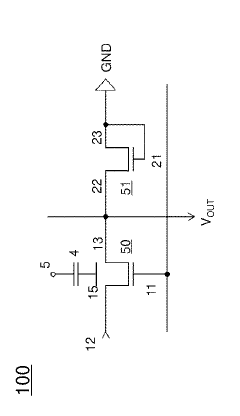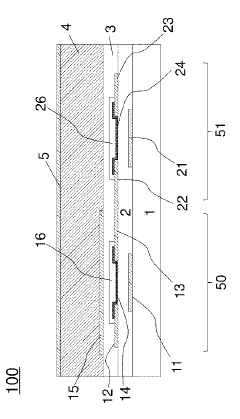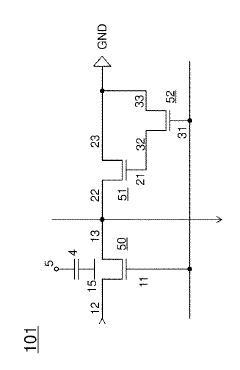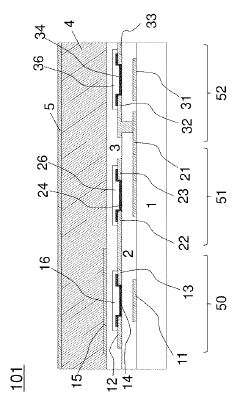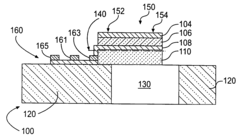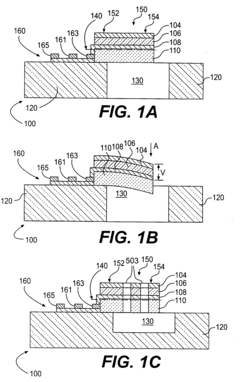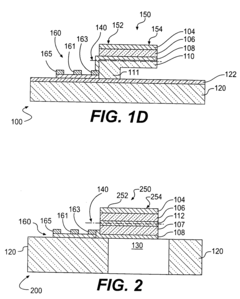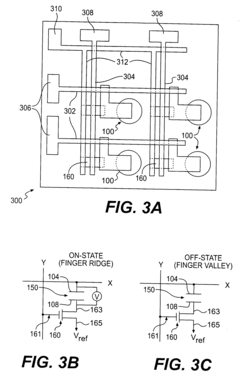Developing Lightweight Piezoelectric Sensor Arrays
JUL 17, 20259 MIN READ
Generate Your Research Report Instantly with AI Agent
Patsnap Eureka helps you evaluate technical feasibility & market potential.
Piezoelectric Sensor Evolution and Objectives
Piezoelectric sensors have undergone significant evolution since their inception in the early 20th century. Initially discovered by the Curie brothers in 1880, the piezoelectric effect has been harnessed for various sensing applications. The development of lightweight piezoelectric sensor arrays represents a crucial advancement in this field, driven by the increasing demand for miniaturization and enhanced sensitivity in modern sensing technologies.
The evolution of piezoelectric sensors can be traced through several key stages. Early applications primarily focused on sonar and ultrasound technologies. As materials science progressed, new piezoelectric materials were developed, expanding the range of applications. The introduction of synthetic materials like lead zirconate titanate (PZT) in the 1950s marked a significant milestone, offering improved performance and manufacturability.
In recent decades, the trend has shifted towards developing more compact and efficient sensor arrays. This shift is driven by the need for high-resolution sensing in fields such as medical imaging, structural health monitoring, and touch-sensitive interfaces. The miniaturization of sensors has been accompanied by advancements in signal processing and integration technologies, enabling the creation of sophisticated sensor arrays capable of capturing complex data with high spatial and temporal resolution.
The primary objective in developing lightweight piezoelectric sensor arrays is to achieve a balance between sensitivity, size, and power efficiency. These arrays aim to provide high-fidelity sensing capabilities while minimizing weight and power consumption, making them ideal for portable and embedded applications. Another key goal is to enhance the flexibility and conformability of these arrays, allowing them to be integrated into curved or irregular surfaces, thus expanding their potential applications in wearable technology and soft robotics.
Researchers are also focusing on improving the durability and reliability of these sensor arrays, addressing challenges such as temperature sensitivity and long-term stability. The development of new piezoelectric materials, including lead-free alternatives and nanostructured composites, is an ongoing area of research aimed at enhancing performance while meeting environmental regulations.
Furthermore, the integration of these sensor arrays with advanced data processing algorithms and artificial intelligence is a critical objective. This integration aims to enable real-time analysis and interpretation of sensor data, opening up new possibilities in fields such as predictive maintenance, gesture recognition, and human-machine interfaces.
As we look to the future, the development of lightweight piezoelectric sensor arrays is expected to play a crucial role in emerging technologies such as Internet of Things (IoT) devices, autonomous vehicles, and advanced robotics. The ongoing research in this field is driven by the vision of creating ubiquitous, highly sensitive, and energy-efficient sensing solutions that can seamlessly integrate into our environment and enhance our interaction with technology.
The evolution of piezoelectric sensors can be traced through several key stages. Early applications primarily focused on sonar and ultrasound technologies. As materials science progressed, new piezoelectric materials were developed, expanding the range of applications. The introduction of synthetic materials like lead zirconate titanate (PZT) in the 1950s marked a significant milestone, offering improved performance and manufacturability.
In recent decades, the trend has shifted towards developing more compact and efficient sensor arrays. This shift is driven by the need for high-resolution sensing in fields such as medical imaging, structural health monitoring, and touch-sensitive interfaces. The miniaturization of sensors has been accompanied by advancements in signal processing and integration technologies, enabling the creation of sophisticated sensor arrays capable of capturing complex data with high spatial and temporal resolution.
The primary objective in developing lightweight piezoelectric sensor arrays is to achieve a balance between sensitivity, size, and power efficiency. These arrays aim to provide high-fidelity sensing capabilities while minimizing weight and power consumption, making them ideal for portable and embedded applications. Another key goal is to enhance the flexibility and conformability of these arrays, allowing them to be integrated into curved or irregular surfaces, thus expanding their potential applications in wearable technology and soft robotics.
Researchers are also focusing on improving the durability and reliability of these sensor arrays, addressing challenges such as temperature sensitivity and long-term stability. The development of new piezoelectric materials, including lead-free alternatives and nanostructured composites, is an ongoing area of research aimed at enhancing performance while meeting environmental regulations.
Furthermore, the integration of these sensor arrays with advanced data processing algorithms and artificial intelligence is a critical objective. This integration aims to enable real-time analysis and interpretation of sensor data, opening up new possibilities in fields such as predictive maintenance, gesture recognition, and human-machine interfaces.
As we look to the future, the development of lightweight piezoelectric sensor arrays is expected to play a crucial role in emerging technologies such as Internet of Things (IoT) devices, autonomous vehicles, and advanced robotics. The ongoing research in this field is driven by the vision of creating ubiquitous, highly sensitive, and energy-efficient sensing solutions that can seamlessly integrate into our environment and enhance our interaction with technology.
Market Demand Analysis for Lightweight Sensor Arrays
The market demand for lightweight piezoelectric sensor arrays has been experiencing significant growth, driven by various industries seeking advanced sensing solutions. These sensor arrays offer unique advantages in terms of weight reduction, flexibility, and energy efficiency, making them highly attractive for a wide range of applications.
In the automotive sector, there is a growing need for lightweight sensors to support the development of electric and autonomous vehicles. These sensor arrays can be integrated into vehicle structures for structural health monitoring, impact detection, and occupant sensing, contributing to improved safety and performance while minimizing weight. The automotive industry's shift towards electrification and autonomy is expected to further boost the demand for these sensors in the coming years.
The aerospace industry is another major driver of market demand for lightweight piezoelectric sensor arrays. With the increasing focus on fuel efficiency and reducing carbon emissions, aircraft manufacturers are constantly seeking ways to reduce weight without compromising safety or performance. These sensor arrays can be used for structural health monitoring, vibration sensing, and acoustic emission detection in aircraft components, enabling predictive maintenance and enhancing overall safety.
In the healthcare sector, there is a growing interest in wearable medical devices and remote patient monitoring systems. Lightweight piezoelectric sensor arrays offer the potential for non-invasive, continuous monitoring of vital signs, body movements, and physiological parameters. This technology can enable more efficient and personalized healthcare delivery, particularly in the context of an aging population and the increasing prevalence of chronic diseases.
The consumer electronics market is also driving demand for lightweight sensor arrays. As devices become smaller, thinner, and more feature-rich, manufacturers are looking for innovative sensing solutions that can be seamlessly integrated into their products. These sensor arrays can be used in smartphones, tablets, and wearable devices for touch sensing, gesture recognition, and haptic feedback, enhancing user experience and device functionality.
In the industrial sector, there is a growing need for advanced sensing technologies to support the development of smart manufacturing and Industry 4.0 initiatives. Lightweight piezoelectric sensor arrays can be used for process monitoring, quality control, and predictive maintenance in various manufacturing applications, contributing to improved efficiency and reduced downtime.
The market for lightweight piezoelectric sensor arrays is expected to continue its growth trajectory in the coming years, driven by technological advancements, increasing adoption across various industries, and the ongoing trend towards miniaturization and weight reduction in electronic devices and systems. As research and development efforts in this field intensify, we can anticipate further improvements in sensor performance, durability, and cost-effectiveness, which will likely expand the potential applications and market opportunities for these innovative sensing solutions.
In the automotive sector, there is a growing need for lightweight sensors to support the development of electric and autonomous vehicles. These sensor arrays can be integrated into vehicle structures for structural health monitoring, impact detection, and occupant sensing, contributing to improved safety and performance while minimizing weight. The automotive industry's shift towards electrification and autonomy is expected to further boost the demand for these sensors in the coming years.
The aerospace industry is another major driver of market demand for lightweight piezoelectric sensor arrays. With the increasing focus on fuel efficiency and reducing carbon emissions, aircraft manufacturers are constantly seeking ways to reduce weight without compromising safety or performance. These sensor arrays can be used for structural health monitoring, vibration sensing, and acoustic emission detection in aircraft components, enabling predictive maintenance and enhancing overall safety.
In the healthcare sector, there is a growing interest in wearable medical devices and remote patient monitoring systems. Lightweight piezoelectric sensor arrays offer the potential for non-invasive, continuous monitoring of vital signs, body movements, and physiological parameters. This technology can enable more efficient and personalized healthcare delivery, particularly in the context of an aging population and the increasing prevalence of chronic diseases.
The consumer electronics market is also driving demand for lightweight sensor arrays. As devices become smaller, thinner, and more feature-rich, manufacturers are looking for innovative sensing solutions that can be seamlessly integrated into their products. These sensor arrays can be used in smartphones, tablets, and wearable devices for touch sensing, gesture recognition, and haptic feedback, enhancing user experience and device functionality.
In the industrial sector, there is a growing need for advanced sensing technologies to support the development of smart manufacturing and Industry 4.0 initiatives. Lightweight piezoelectric sensor arrays can be used for process monitoring, quality control, and predictive maintenance in various manufacturing applications, contributing to improved efficiency and reduced downtime.
The market for lightweight piezoelectric sensor arrays is expected to continue its growth trajectory in the coming years, driven by technological advancements, increasing adoption across various industries, and the ongoing trend towards miniaturization and weight reduction in electronic devices and systems. As research and development efforts in this field intensify, we can anticipate further improvements in sensor performance, durability, and cost-effectiveness, which will likely expand the potential applications and market opportunities for these innovative sensing solutions.
Current Challenges in Piezoelectric Array Miniaturization
The miniaturization of piezoelectric sensor arrays presents several significant challenges that researchers and engineers must overcome to develop lightweight and compact devices. One of the primary obstacles is the reduction of sensor element size without compromising sensitivity and performance. As the dimensions of piezoelectric materials decrease, their output voltage and charge generation capacity tend to diminish, potentially leading to reduced signal-to-noise ratios and decreased overall system sensitivity.
Another critical challenge lies in the integration and packaging of miniaturized sensor arrays. As the size of individual sensors shrinks, the complexity of interconnections and wiring increases exponentially. This complexity not only complicates the manufacturing process but also introduces potential points of failure and signal degradation. Moreover, the dense packing of sensors can lead to increased crosstalk between adjacent elements, affecting the array's spatial resolution and accuracy.
The selection of appropriate materials for miniaturized piezoelectric arrays poses another significant hurdle. Traditional piezoelectric materials may not exhibit the same properties or performance when scaled down to micro or nano dimensions. Researchers must explore novel materials or composites that maintain high piezoelectric coefficients and mechanical stability at reduced scales. Additionally, the integration of these materials with other components, such as flexible substrates or microelectronics, presents its own set of challenges in terms of compatibility and fabrication processes.
Power management and energy harvesting represent further areas of concern in the development of lightweight piezoelectric sensor arrays. As devices become smaller, the available power for operation decreases, necessitating highly efficient power management systems. Simultaneously, the potential for energy harvesting from ambient vibrations or motion becomes more limited due to the reduced size of the piezoelectric elements, requiring innovative approaches to maximize energy capture and utilization.
Lastly, the miniaturization process must address the challenge of maintaining or improving the durability and reliability of the sensor arrays. Smaller components are often more susceptible to mechanical stress, thermal fluctuations, and environmental factors. Ensuring long-term stability and consistent performance under various operating conditions becomes increasingly difficult as the size of the array decreases. This challenge extends to the development of robust protective encapsulations that do not significantly increase the overall size or weight of the device.
Another critical challenge lies in the integration and packaging of miniaturized sensor arrays. As the size of individual sensors shrinks, the complexity of interconnections and wiring increases exponentially. This complexity not only complicates the manufacturing process but also introduces potential points of failure and signal degradation. Moreover, the dense packing of sensors can lead to increased crosstalk between adjacent elements, affecting the array's spatial resolution and accuracy.
The selection of appropriate materials for miniaturized piezoelectric arrays poses another significant hurdle. Traditional piezoelectric materials may not exhibit the same properties or performance when scaled down to micro or nano dimensions. Researchers must explore novel materials or composites that maintain high piezoelectric coefficients and mechanical stability at reduced scales. Additionally, the integration of these materials with other components, such as flexible substrates or microelectronics, presents its own set of challenges in terms of compatibility and fabrication processes.
Power management and energy harvesting represent further areas of concern in the development of lightweight piezoelectric sensor arrays. As devices become smaller, the available power for operation decreases, necessitating highly efficient power management systems. Simultaneously, the potential for energy harvesting from ambient vibrations or motion becomes more limited due to the reduced size of the piezoelectric elements, requiring innovative approaches to maximize energy capture and utilization.
Lastly, the miniaturization process must address the challenge of maintaining or improving the durability and reliability of the sensor arrays. Smaller components are often more susceptible to mechanical stress, thermal fluctuations, and environmental factors. Ensuring long-term stability and consistent performance under various operating conditions becomes increasingly difficult as the size of the array decreases. This challenge extends to the development of robust protective encapsulations that do not significantly increase the overall size or weight of the device.
Existing Lightweight Array Design Solutions
01 Lightweight piezoelectric sensor array designs
Innovative designs for piezoelectric sensor arrays focus on reducing overall weight while maintaining sensitivity. These designs incorporate lightweight materials and optimized structures to minimize mass without compromising performance. Techniques include using thin-film piezoelectric materials, micro-fabrication processes, and advanced composite structures to create ultra-lightweight sensor arrays suitable for various applications.- Lightweight piezoelectric sensor array designs: Innovative designs for piezoelectric sensor arrays focus on reducing overall weight while maintaining sensitivity. These designs may incorporate thin-film piezoelectric materials, micro-electromechanical systems (MEMS) technology, or advanced composite structures to minimize mass while maximizing performance. Such lightweight arrays are particularly useful in applications where weight is a critical factor, such as in aerospace or portable devices.
- Weight distribution optimization in sensor arrays: Techniques for optimizing weight distribution across piezoelectric sensor arrays to enhance their performance and durability. This may involve strategic placement of sensors, use of supporting structures, or integration of weight-balancing elements. Proper weight distribution can improve the array's response to stimuli, reduce stress on individual components, and extend the overall lifespan of the sensor system.
- Integration of lightweight materials in array construction: Incorporation of lightweight materials such as polymers, carbon fiber composites, or advanced ceramics in the construction of piezoelectric sensor arrays. These materials can significantly reduce the overall weight of the array while maintaining or even improving its mechanical and electrical properties. The use of such materials often requires specialized manufacturing techniques to ensure proper integration with the piezoelectric elements.
- Weight-sensitive applications of piezoelectric arrays: Development of piezoelectric sensor arrays specifically designed for weight-sensitive applications. These may include wearable technology, aerospace instruments, or medical devices where the weight of the sensor array itself is a critical factor in the overall system performance. Such applications often require innovative approaches to miniaturization and integration of sensor components.
- Weight reduction techniques for large-scale sensor arrays: Methods for reducing the weight of large-scale piezoelectric sensor arrays used in applications such as structural health monitoring or seismic detection. These techniques may involve the use of distributed sensor networks, modular array designs, or advanced signal processing algorithms that allow for fewer physical sensors without compromising detection capabilities. The goal is to achieve comprehensive sensing coverage while minimizing the overall weight of the system.
02 Weight distribution in piezoelectric sensor arrays
Effective weight distribution is crucial in piezoelectric sensor array design. This involves strategically placing sensor elements and supporting structures to balance the array's weight across its surface. Optimized weight distribution enhances the array's stability, reduces stress on individual components, and improves overall performance and durability.Expand Specific Solutions03 Integration of lightweight materials in sensor arrays
The use of lightweight materials in piezoelectric sensor arrays significantly reduces their overall weight. Materials such as advanced polymers, carbon-based composites, and nanomaterials are incorporated into array designs. These materials offer high strength-to-weight ratios, allowing for the creation of robust yet lightweight sensor structures.Expand Specific Solutions04 Miniaturization techniques for weight reduction
Miniaturization plays a key role in reducing the weight of piezoelectric sensor arrays. Advanced fabrication techniques, such as MEMS (Micro-Electro-Mechanical Systems) technology, allow for the creation of extremely small and lightweight sensor elements. This miniaturization not only reduces weight but also enables higher sensor density and improved spatial resolution.Expand Specific Solutions05 Weight optimization in multi-layer piezoelectric arrays
Multi-layer piezoelectric sensor arrays present unique challenges and opportunities for weight optimization. Techniques include using alternating layers of active and passive materials, optimizing layer thicknesses, and employing advanced bonding methods. These approaches allow for the creation of highly sensitive, multi-functional arrays while minimizing overall weight.Expand Specific Solutions
Key Players in Piezoelectric Sensor Industry
The development of lightweight piezoelectric sensor arrays is in a growth phase, with increasing market demand driven by applications in wearable technology, IoT devices, and structural health monitoring. The global market size for piezoelectric sensors is projected to reach several billion dollars by 2025. Technologically, while basic piezoelectric principles are well-established, innovations in materials, fabrication techniques, and miniaturization are advancing rapidly. Key players like Agilent Technologies, Sony, and General Electric are investing heavily in R&D, while academic institutions such as Drexel University and Xi'an Jiaotong University are contributing fundamental research. Emerging companies like Advanced Wave Sensors are also making strides in specialized applications, indicating a dynamic and competitive landscape in this field.
Sumitomo Riko Co. Ltd.
Technical Solution: Sumitomo Riko has developed a novel approach to lightweight piezoelectric sensor arrays using electrospun nanofibers. Their technology involves creating aligned arrays of piezoelectric polymer nanofibers, such as polyvinylidene fluoride (PVDF), which are then integrated into flexible sensor matrices. This method allows for extremely lightweight and conformable sensors with high sensitivity to mechanical deformation[5]. Sumitomo Riko's arrays feature a unique hierarchical structure, combining nanoscale fibers with microscale electrode patterns to optimize charge collection. The company has also developed proprietary encapsulation techniques to enhance the durability and environmental resistance of their sensors, making them suitable for harsh operating conditions.
Strengths: Extremely lightweight, highly flexible, and adaptable to complex geometries. Weaknesses: Lower voltage output compared to ceramic-based piezoelectrics, potential long-term stability issues in certain environments.
Sony Group Corp.
Technical Solution: Sony has made significant strides in developing lightweight piezoelectric sensor arrays for consumer electronics and IoT applications. Their approach focuses on creating ultra-thin, large-area sensors using organic piezoelectric materials. Sony's proprietary technology involves the synthesis of high-performance piezoelectric polymers that can be solution-processed, enabling low-cost, large-scale fabrication[6]. The company has developed a unique multilayer structure that enhances the overall piezoelectric response while maintaining flexibility. Sony's arrays incorporate advanced signal processing algorithms implemented on custom low-power microcontrollers, allowing for intelligent event detection and power management. Recent developments include the integration of these sensors into smart fabrics and wearable devices for health monitoring and human-machine interfaces[7].
Strengths: Low-cost scalable production, compatibility with flexible electronics, and advanced signal processing capabilities. Weaknesses: Lower piezoelectric coefficients compared to inorganic materials, potential long-term stability issues in harsh environments.
Core Innovations in Piezoelectric Nanomaterials
Piezoelectric sensor and piezoelectric sensor array
PatentInactiveJP2021063737A
Innovation
- A piezoelectric sensor element and array design that includes multiple thin film transistors with a piezoelectric layer, where the charge generated by the piezoelectric layer is converted into a voltage value using a second thin film transistor, and a specific wiring configuration minimizes the impact of wiring resistance and parasitic capacitance.
Piezoelectric cantilever pressure sensor array
PatentInactiveUS20050193823A1
Innovation
- A piezoelectric cantilever pressure sensor array is developed, comprising a substrate, readout circuit, and piezoelectric cantilever pressure sensors with a first and second electrode and a piezoelectric element between them, capable of generating a measurable voltage under finger pressure, allowing for accurate fingerprint recognition with low power input and cost-effective manufacturing.
Environmental Impact of Piezoelectric Materials
The environmental impact of piezoelectric materials used in lightweight sensor arrays is a critical consideration in their development and deployment. These materials, while offering significant advantages in sensing and energy harvesting applications, also present potential environmental challenges throughout their lifecycle.
During the production phase, the manufacturing of piezoelectric materials often involves the use of lead-based compounds, particularly lead zirconate titanate (PZT). The extraction and processing of lead can result in soil and water contamination if not properly managed. Additionally, the synthesis of these materials may require energy-intensive processes and the use of hazardous chemicals, contributing to greenhouse gas emissions and potential environmental risks.
In the operational phase, piezoelectric sensor arrays generally have a low environmental footprint due to their energy efficiency and ability to generate electricity from ambient vibrations. This self-powering capability can reduce the need for external power sources and battery replacements, thereby minimizing electronic waste. However, the long-term durability and stability of these materials in various environmental conditions need to be carefully assessed to ensure sustained performance without frequent replacements.
End-of-life considerations for piezoelectric materials are particularly important. The presence of lead in many piezoelectric compounds poses a significant challenge for disposal and recycling. Improper disposal can lead to leaching of toxic substances into the environment, affecting ecosystems and human health. Developing effective recycling methods for these materials is crucial to mitigate their environmental impact and recover valuable components.
Recent research has focused on developing lead-free piezoelectric materials to address these environmental concerns. Alternatives such as bismuth sodium titanate (BNT) and potassium sodium niobate (KNN) show promise in reducing the reliance on lead-based piezoelectrics. These materials aim to offer comparable performance while significantly reducing the environmental risks associated with lead toxicity.
The miniaturization trend in piezoelectric sensor arrays, while beneficial for reducing material usage, also presents challenges in terms of recyclability and separation of components. As these devices become smaller and more integrated, the complexity of recycling increases, potentially leading to more e-waste if not addressed through innovative recycling technologies.
In conclusion, while piezoelectric materials offer significant benefits for lightweight sensor arrays, their environmental impact must be carefully managed. Balancing performance requirements with environmental sustainability is crucial for the long-term viability of this technology. Ongoing research into eco-friendly materials and improved lifecycle management strategies will be key to minimizing the environmental footprint of piezoelectric sensor arrays.
During the production phase, the manufacturing of piezoelectric materials often involves the use of lead-based compounds, particularly lead zirconate titanate (PZT). The extraction and processing of lead can result in soil and water contamination if not properly managed. Additionally, the synthesis of these materials may require energy-intensive processes and the use of hazardous chemicals, contributing to greenhouse gas emissions and potential environmental risks.
In the operational phase, piezoelectric sensor arrays generally have a low environmental footprint due to their energy efficiency and ability to generate electricity from ambient vibrations. This self-powering capability can reduce the need for external power sources and battery replacements, thereby minimizing electronic waste. However, the long-term durability and stability of these materials in various environmental conditions need to be carefully assessed to ensure sustained performance without frequent replacements.
End-of-life considerations for piezoelectric materials are particularly important. The presence of lead in many piezoelectric compounds poses a significant challenge for disposal and recycling. Improper disposal can lead to leaching of toxic substances into the environment, affecting ecosystems and human health. Developing effective recycling methods for these materials is crucial to mitigate their environmental impact and recover valuable components.
Recent research has focused on developing lead-free piezoelectric materials to address these environmental concerns. Alternatives such as bismuth sodium titanate (BNT) and potassium sodium niobate (KNN) show promise in reducing the reliance on lead-based piezoelectrics. These materials aim to offer comparable performance while significantly reducing the environmental risks associated with lead toxicity.
The miniaturization trend in piezoelectric sensor arrays, while beneficial for reducing material usage, also presents challenges in terms of recyclability and separation of components. As these devices become smaller and more integrated, the complexity of recycling increases, potentially leading to more e-waste if not addressed through innovative recycling technologies.
In conclusion, while piezoelectric materials offer significant benefits for lightweight sensor arrays, their environmental impact must be carefully managed. Balancing performance requirements with environmental sustainability is crucial for the long-term viability of this technology. Ongoing research into eco-friendly materials and improved lifecycle management strategies will be key to minimizing the environmental footprint of piezoelectric sensor arrays.
Standardization of Piezoelectric Sensor Testing
The standardization of piezoelectric sensor testing is crucial for ensuring consistent performance and reliability in lightweight piezoelectric sensor arrays. This process involves establishing uniform methods and criteria for evaluating sensor characteristics across different manufacturers and applications.
A key aspect of standardization is the development of reference materials and calibration procedures. These provide a common baseline for comparing sensor outputs and sensitivities. Standardized reference materials, such as precisely engineered piezoelectric crystals with known properties, allow for accurate calibration of testing equipment and enable meaningful comparisons between different sensor designs.
Test protocols form another essential component of standardization efforts. These protocols define specific procedures for measuring key performance parameters, including sensitivity, frequency response, linearity, and temperature dependence. By adhering to standardized test methods, researchers and manufacturers can ensure that their results are reproducible and comparable across different laboratories and testing facilities.
Environmental testing standards are particularly important for lightweight piezoelectric sensor arrays, as these devices often operate in challenging conditions. Standardized procedures for evaluating sensor performance under various temperature, humidity, and vibration conditions help predict long-term reliability and identify potential failure modes.
Electrical characterization standards define methods for measuring important electrical properties such as capacitance, dissipation factor, and impedance. These standards ensure that sensors meet the necessary electrical specifications for integration into larger systems and provide consistent performance across different operating conditions.
Mechanical testing standards are crucial for evaluating the durability and structural integrity of lightweight sensor arrays. These standards may include procedures for assessing fatigue resistance, impact tolerance, and adhesion strength of sensor elements to substrates.
Data reporting and analysis standards play a vital role in ensuring that test results are presented in a consistent and easily interpretable format. This includes specifying units of measurement, defining acceptable error margins, and establishing protocols for statistical analysis of test data.
Interlaboratory comparison programs are an important aspect of maintaining and improving testing standards. These programs involve multiple laboratories testing identical samples and comparing results, helping to identify and resolve discrepancies in testing methodologies and equipment calibration.
As the field of lightweight piezoelectric sensor arrays continues to evolve, standardization efforts must keep pace with technological advancements. This requires ongoing collaboration between industry, academia, and standards organizations to develop and refine testing protocols that address the unique challenges posed by emerging sensor designs and applications.
A key aspect of standardization is the development of reference materials and calibration procedures. These provide a common baseline for comparing sensor outputs and sensitivities. Standardized reference materials, such as precisely engineered piezoelectric crystals with known properties, allow for accurate calibration of testing equipment and enable meaningful comparisons between different sensor designs.
Test protocols form another essential component of standardization efforts. These protocols define specific procedures for measuring key performance parameters, including sensitivity, frequency response, linearity, and temperature dependence. By adhering to standardized test methods, researchers and manufacturers can ensure that their results are reproducible and comparable across different laboratories and testing facilities.
Environmental testing standards are particularly important for lightweight piezoelectric sensor arrays, as these devices often operate in challenging conditions. Standardized procedures for evaluating sensor performance under various temperature, humidity, and vibration conditions help predict long-term reliability and identify potential failure modes.
Electrical characterization standards define methods for measuring important electrical properties such as capacitance, dissipation factor, and impedance. These standards ensure that sensors meet the necessary electrical specifications for integration into larger systems and provide consistent performance across different operating conditions.
Mechanical testing standards are crucial for evaluating the durability and structural integrity of lightweight sensor arrays. These standards may include procedures for assessing fatigue resistance, impact tolerance, and adhesion strength of sensor elements to substrates.
Data reporting and analysis standards play a vital role in ensuring that test results are presented in a consistent and easily interpretable format. This includes specifying units of measurement, defining acceptable error margins, and establishing protocols for statistical analysis of test data.
Interlaboratory comparison programs are an important aspect of maintaining and improving testing standards. These programs involve multiple laboratories testing identical samples and comparing results, helping to identify and resolve discrepancies in testing methodologies and equipment calibration.
As the field of lightweight piezoelectric sensor arrays continues to evolve, standardization efforts must keep pace with technological advancements. This requires ongoing collaboration between industry, academia, and standards organizations to develop and refine testing protocols that address the unique challenges posed by emerging sensor designs and applications.
Unlock deeper insights with Patsnap Eureka Quick Research — get a full tech report to explore trends and direct your research. Try now!
Generate Your Research Report Instantly with AI Agent
Supercharge your innovation with Patsnap Eureka AI Agent Platform!
